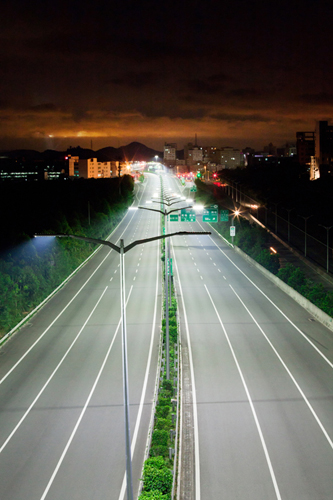LED and high pressure sodium are two major lighting technologies that used in road lighting applications, including highway lighting. They are two different lighting sources. Lighting effects (luminous flux, service life, CRI, color temperature, light intensity, light efficiency) are various due to totally different lighting principles.

High pressure sodium lamps have higher light efficiency, longer working life, stronger penetrability and free of bugs. Normally, the power consumption of high pressure sodium lamps can reach up to several KW, which can satisfy most lighting requirements. After being developing for several decade years, the lighting sources and technologies have already been full-fledged. Thus the production costs of these products dropped into a certain low level. For example, the average price of high pressure sodium tunnel lamps with high IP levels is only hundreds yuan. Although high pressure sodium lamps have been widely used in road lighting and tunnel lighting field, they still have some disadvantages that hard to be improved: 1) lower color temperature, normally send out yellow rays. And also lower CRI, only 20% of the natural light. 2) Although that high-powered high pressure sodium lights satisfied almost all demands from customers in illumination aspect, they still consumed too much energy. Traditional high pressure sodium lighting systems often loaded heavy burdens on operators’ shoulders. High pressure sodium lights have relatively short service life. According to its technology, the best lamps can only maintain a normal work for about 25,000 hours. In some rural areas, with very unstable power grids and severe weather conditions, the life of lighting sources of high pressure sodium lamps will be even shorter.
As the fourth generation of lighting sources, LED highway lighting applications have following advantages: 1) soft rays, high CRI (much closed to the sunlight compared with light generated by high pressure sodium lamps). 2) Fast respond in the switch on/off, almost no delay and these processes will cause ignorable damages to the lamps. 3) LEDs have longer service life; also some disadvantages: 1) Since LEDs are semiconductor lighting sources, they over-heated working conditions will reduce their theoretical working lives. Thus, cooling problem was always one of the biggest troubles for LED highway lighting application manufactures. 3) Poor penetration, when used in tunnels (in the high way), a good penetration of lamps will reduce the risk of accidents.
Both high pressure sodium lamps and LED highway lighting products have their advantages and disadvantages. Although LED lights are more sophisticated than high pressure sodium lamps in many ways, there still a lot of problems need to be solved.
